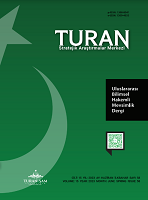VARIOUS LINGUISTIC CHARACTERISTICS OF PAREMIOLOGICAL UNITS IN THE AZERBAIJANI AND ENGLISH LANGUAGES (IN TERMS OF SYNTACTIC-SEMANTIC APPROACH)
VARIOUS LINGUISTIC CHARACTERISTICS OF PAREMIOLOGICAL UNITS IN THE AZERBAIJANI AND ENGLISH LANGUAGES (IN TERMS OF SYNTACTIC-SEMANTIC APPROACH)
Author(s): Gulshan MAHARRAMOVASubject(s): Morphology, Syntax, Semantics, Comparative Linguistics
Published by: Sage Yayınları
Keywords: Paremiological units; structural-semantic features; the Azerbaijani and English languages; communicative function; grammatical relationship;
Summary/Abstract: Paremiological units consist of proverbs, sayings, idioms and fixed combinations that are manifested in distinguishable versions of the language, fully express the realities happening in society, and are the product of national thinking. The study of proverbs with different contents as a result of the historical development of the language as an object of both phraseology and paremiology. In this regard, changing the order of lexical units in proverbs can disrupt the syntax of the expression and reduce its impact. This fact is explained by the fact that those compositions have already received a fixed form and are communicatively standardized as a result of the interaction of national language and thought. The main factor for the sentence-level phraseological units is their syntactic stability, communicative function, and having multi components. The general part of the sentence includes various structural and grammatical elements that contain two cores - two components of the overall structure, i.e. the complexity of paremia. The homogeneity of different structures (in particular, the homogeneity of predicates) and the general part of the sentence in the structure of the components of paremias are two sides of the same phenomenon, which can be characterized as a systematic correlation of the “complex whole” components. As a consequence, paremias with a complex structure are similar to complex sentences only in their syntactic arrangement. Paremias with subordinate complex sentence structure are more often observed in the Azerbaijani language. A similar can be observed when looking at the materials in English. In these constructions, the components, the superordinate and subordinate sentences, express a metaphorical general meaning, moving away from their real meaning. Paremias in the form of subordinate complex sentences have different structures depending on the grammatical relationship between the components. Our observations show that such paremic units are mostly found in the subordinate complex sentence structure with adverbial clauses. One of the factors characterizing the structural-semantic features of paremiological units in the Azerbaijani and English languages is the active processing of the thematic group of words in these expressions. The thematic group of words express different shades of meaning according to the context in the content of paremiological units. Although proverbs and idioms in the Azerbaijani and English languages have different semantic composition as a product of national thinking, there are the number of expressions that are close to each other in content and there is a serious need for a comparative study of the paremiological units of both languages from assorted angles.
Journal: TURAN-SAM
- Issue Year: 15/2023
- Issue No: 58
- Page Range: 183-188
- Page Count: 6
- Language: English

